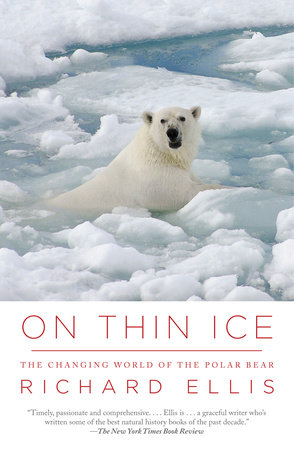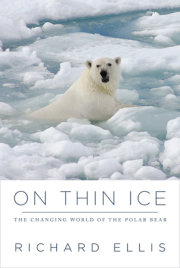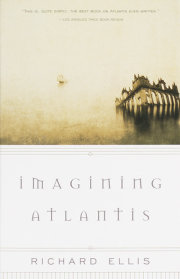I
Introduction
It was about 6:00 a.m. on July 18, 1994. I was in my little cabin aboard the Russian icebreaker
Kapitan Dranitsyn, heading for the North Pole. I was a lecturer representing the American Museum of Natural History, to talk to the paying guests about Arctic mammalian wildlife, including seals, whales, walruses, and whatever else showed up. François Vuilleumier, the Swiss-born AMNH curator of ornithology, would identify and discuss the various gulls, terns, jaegers, and geese that we encountered en route. Our AMNH group shared the expedition with one from Harvard's Museum of Comparative Zoology, led by the museum's director, Jim McCarthy. An announcement came over the PA system that a "polar bear is close to the ship." As I rushed to get dressed—we were near the North Pole, and running out in a T-shirt and shorts was not an option—I thought about how extraordinary this was. We had already spotted a couple of polar bears, but they were so far away, and white against a backdrop of snow and ice, that it was usually a case of: "There . . . over that little ridge . . . no, not that one, the bluish one with the pile of ice in front of it . . . see that white thing moving . . . that's the bear." I was wearing a parka, snow pants, and boots, and I'd stuffed five rolls of film in my pockets for my Minolta 35mm camera with a 35/300 zoom lens. The cabins on the
Dranitsyn were stacked below the bridge in the forward superstructure—somebody once described the 434-foot-long icebreaker as "a block of flats on a barge"—so getting to the foredeck required hustling down five flights of stairs. I reached the foredeck level, opened the door, and got smacked in the face by the early-morning Arctic cold.
As I stepped out on deck, I saw nothing but ice, a vast white landscape interrupted only by an occasional flash of pale aquamarine where the ice had broken, cracked, or melted. Where two rafts had come together, pressure ridges formed into crumbled mounds of broken ice that rose above the otherwise colorless, water-level landscape. The sky mirrored the cold, dull monochrome of the icy plain surrounding us. A large group of people were clustered at the forward port rail, obviously looking at something. I pushed my way to the rail and looked down. Standing on the ice on his hind legs, waiting for crewmen to throw him another slice of bread, was a full-grown polar bear.
We had just left Franz Josef Land, an unoccupied archipelago in the northeastern Barents Sea, north of Novaya Zemlya, and 600 miles from the North Pole. In 1872, the Austrian explorers Karl Weyprecht and Julius Payer, seeking the Northeast Passage in the
Admiral Tegetthoff, became trapped in the pack ice at Novaya Zemlya and drifted for a year, finally finding land in August 1873. (A replica of the
Tegetthoff, built by an Austrian film crew and then abandoned, remains on the ice, a skeletal contrast to the rumbling behemoths in which we were heading for the pole.) Weyprecht and Payer had accidentally discovered a previously unknown group of islands, which they named Franz Josef Land after their emperor. After spending a year exploring the islands, they abandoned their ship and journeyed in a small boat for ninety-six days to Novaya Zemlya. Fridtjof Nansen tried to reach the pole in 1893 by drifting in the specially reinforced
Fram, but when he found himself heading in the wrong direction, he left the ship with Hjalmar Johansen and attempted to reach his goal by sledge. They had to turn back, and spent the winter of 1896 in a stone hut with a walrus-skin roof on Franz Josef Land. During his three-year stay, Nansen became the first man to map this complicated collection of islands. In 1926 Franz Josef Land was annexed by the Soviet Union, and remote weather stations were erected.
When the bear got tired of the bread—or more likely, when the crewmen got tired of throwing it—he resumed his normal all-fours position and began to circle the ship. We were on the foredeck, some thirty feet above the bear, so he paid no attention to us, just walking slowly, swinging his head, and sniffing the ice. As he changed his position, the angle of the light also changed, so our photographs would appear to show any number of different bears walking in any number of different landscapes, but in fact there was only one bear. After about half an hour, he lost interest and wandered off, which gave us a great opportunity to photograph a polar bear from the rear. As we watched the bear depart, we realized that we had just had a rare and wonderful experience: we had seen one of nature's most spectacular predators; we were able to photograph a dangerous wild animal at absolutely no risk. (At other times on this voyage, when we stopped—or were stopped by the ice—and took a walk, we were always accompanied by a Russian sailor with a rifle.)
We were following another icebreaker, the nuclear-powered
Yamal, which could summon 75,000 horsepower to our puny 24,000, and could therefore break more ice than we could. Unlike the South Pole, which is located in the middle of the Antarctic Continent, the North Pole is actually under water. Antarctica is a huge rocky landmass, covered by an ice sheet that may be as much as three miles thick, but here in the North, there is only water in a corresponding location. The North Polar ice cap accumulates every winter, a direct result of the Arctic Ocean freezing. The ice can be as much as twelve feet thick, and icebreakers do not plow through it, but rather ride up on it, relying on the weight of the steel-strengthened bow to break it—(
Yamal, for example, displaces 23,000 tons)—thus creating a path which allows the ship to perform the same feat over and over again. There were times when Yamal failed to make a path and had to come about to try a different location. In a driving snowstorm, on July 21, three days after we saw the bear,
Yamal sounded her whistle to announce that she had arrived at 90°00'N: the North Pole. The passengers dressed warmly and disembarked for a picnic. We had borscht, barbecued meats, lots of potatoes, and a generous supply of champagne and vodka for the celebratory toasts. Of course there is no "pole" there, but enterprising crew members had brought along a bright red metal pole with a banner atop it that said NORTH POLE 90 NORTH, and everybody took the opportunity to pose with it for a photograph.
By 1994, according to my calculations, the total number of people that had ever been to the North Pole, including explorers (by land, sea, and snowmobile), icebreaker crews and passengers, and submariners, was around 2,800. The passengers of
Yamal and
Kapitan Dranitsyn were therefore in very exalted company, and as we stood around congratulating ourselves for our singular feat of "exploration," a few hardy Russian crew members began enlarging the hole in the ice where the bow of
Yamal had actually reached the pole. In addition to our shipboard triumph, we were going to be offered another opportunity for exclusive celebrity: we could go for a swim at the North Pole. In 1975, Canadian diver/doctor Joe MacInnis had taken England's Prince Charles on a scuba dive at the North Pole, but that was for TV. Our swim was for personal glory. One at a time, those of us who opted for the plunge removed our outer clothing and stripped down to our skivvies, and a great hawser was tied around our waists to make sure we could be hauled out in case we panicked and got trapped under the ice. I jumped in feet first, yowled from the shock of the ice-cold water, and was yanked out immediately. Russian sailors, who didn't seem to mind the cold and were wearing nothing more than skimpy European bathing suits, were standing by with towels and a much-needed shot of vodka.
In July 1994, the North Polar ice cap was ten feet thick, and our two icebreakers had a hell of a time crunching through to the North Pole. In August 2000, when Jim McCarthy returned on another North Pole cruise (this time aboard
Yamal), he was amazed to see that where we had encountered a thick and almost impenetrable ice sheet six years earlier, he saw only open water. Malcolm McKenna, an AMNH paleontologist and lecturer, took the photograph that was reproduced on the front page of the
New York Times, alongside an article ("Age-Old Icecap at North Pole Is Now Liquid, Scientists Find") written by science reporter John Noble Wilford. McCarthy and McKenna then coauthored an article—"Meltdown at the North Pole"—in the December 2000 issue of the science and policy magazine
Environment. Their article and Wilford's piece in the
Times, dated August 19, 2000, were among the first "popular" reports to discuss the diminution of the Arctic ice cap.
Upon encountering open water where there used to be thick ice, McCarthy, identified as "the co-leader of a group working for the Intergovernmental Panel on Climate Change," said, "It was totally unexpected . . . I don't know if anybody in history ever got to ninety degrees north to be greeted by water, not ice." McCarthy and McKenna wrote in their article in
Environment,
During the summer of 2000, the authors traveled, as part of a team of lecturers, aboard a Russian nuclear icebreaker to the North Pole. The lecturers were well-informed regarding recent scientific papers that discussed climate change in the Arctic, but had no expectations that any of this would be visible to casual observers like ourselves. However, a paucity of ice greeted us along our journey—there was open water at the North Pole—and upon the ship's return, those observations quickly made their way into a global web of print and electronic media.Long before the
Times article bemoaned the disappearing ice, polar bear scientists like Ian Stirling and Andrew Derocher were warning that climatic warming would affect the bears. In a 1993 article in the journal
Arctic, they wrote,
Eventually . . . it is likely that seal populations will decline wherever the quality and availability of breeding habitat are reduced. Rain during the late winter may cause polar bear maternity dens to collapse, causing the death of the occupants. Human-bear problems will increase as the open water period becomes longer and bears fasting and relying on their fat reserves become food stressed . . . Should the Arctic Ocean become seasonally ice-free for a long enough period, it is likely that polar bears would become extirpated from at least the southern portion of their range. If climatic warming occurs, the polar bear is an ideal species through which to monitor the cumulative effects in arctic marine ecosystems because of its position at the top of the arctic marine food chain.
It took a while before this message made it into the popular consciousness. In an interview ("Some Don't Like It Hot") given to the
Harvard Gazette in March 2001, McCarthy said, "Thinning ice has made it harder for the bears to hunt, leading to weight loss and 10 percent fewer cubs than 20 years ago. We already see effects that the change in climate has engendered, and the projection of some of those effects into the future do not make a pretty scene."
Even though it was obvious to the observers aboard the
Yamal that there was no ice at the North Pole in August 2000, the open water did not necessarily signify a meltdown of the Arctic ice cap. Wilford wrote, "The North Pole is melting . . . [and] at least for the time being, an ice free patch of ocean about a mile wide has opened at the very top of the world, something that has never before been seen by humans . . . ," but he did not say that there was no ice to be seen. (In fact, the photograph shows the bow of the
Yamal breaking through the ice, then open water, then more ice ahead of the ship. According to Wilford, "The
Yamal had to steam six miles away to find ice thick enough for the 100 passengers to get out and be able to say they had stood on the North Pole, or close to it.") What the observers actually saw was a mile-wide lead—a break in the floating sea ice—or a
polynya—a wider swath of open water in sea ice. It would be several years before climatologists voiced their concerns that the North Pole might not ever be covered by sea ice again, regardless of season.
The articles describing open water at the North Pole also marked the beginning of the denial of global warming as the cause. McCarthy and McKenna wrote,
There were attempts to cast doubts on our credentials to observe what we saw . . . The negative op-ed columns were authored by people who clearly feared that some readers would see our simple observations as being consistent with the strong scientific case that Earth's climate is changing in ways that can be expected from anthropogenic greenhouse gas-forcing. Those authors prefer to believe that there is no scientific evidence for recent climate change.
Copyright © 2010 by Richard Ellis. All rights reserved. No part of this excerpt may be reproduced or reprinted without permission in writing from the publisher.









